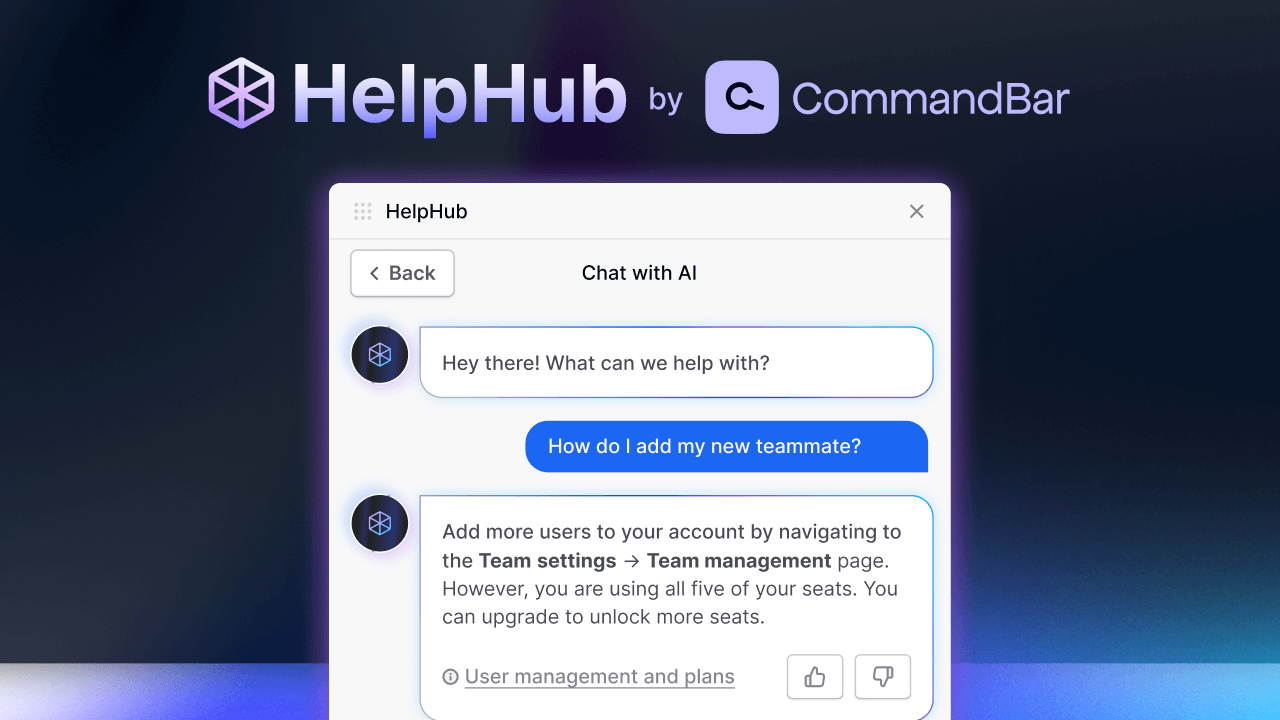Why we built HelpHub
Combining help docs and human-authored FAQs with AI chat, to give any website an AI-powered chatbot.

We started Command AI 3 years ago with the goal of creating a natural language interface for the internet, to help users wield software. We started with the eponymous command bar and have added pieces to the platform since (like nudges and questlists a few months ago).
Today, we’re launching a new widget that is perhaps the best expression of our original vision that we’ve built today.
HelpHub is our new interface for assisting users in-app. It combines the best of “mainstream” user help — help docs and human-authored FAQs — with AI chat, to give any website an AI-powered chatbot.
We think AI is about to change software interfaces in a big way. Both changing the way interfaces are built, and creating step-change opportunities to assist users in personalized ways that were previously impractical. HelpHub is our first step in that direction.
Here’s how it works.
Setup
We build mostly no-code tools at Command AI, but we wanted to take this a step further with HelpHub. The goal is for anyone with a website — whether that's a web app, marketing site, blog, or Shopify store — to be able to wield it.
The end result is that the setup is trivial.
Step 1

Add some source content. You can do this in a few ways:
- Enter a URL to crawl any website
- Upload manually
- Sync a CMS ((like Intercom, Zendesk, or even a warehouse management system).
The content you upload will be used for two purposes — (1) to train your chatbot, (2) to allow users to search through the content directly.
Step 2
At this point, you have a fully functional HelpHub. You can try it out by chatting or searching with your HelpHub in Command AI Studio.
But you can spruce it up a bit by adding some styling and recommendation sets. Recommendation sets define what default content users see when they first open HelpHub. You can customize this based on the page the user’s on or user properties (like whether they’re a new user or paying customer).

Step 3
Launch it to users. For most apps, you can do this by pasting an embed snippet.
Users can access HelpHub by clicking on a floating launcher. Or you can tag a button to open HelpHub.
Quirks and features
We wanted to build something that was an order of magnitude better than what a user could achieve by opening a ChatGPT tab in their browser.
Hallucinations
The main way in which we did this was by making it so that your chatbot only uses information contained in its source content to answer questions. This means you can be sure that your bot isn’t going to reference an outdated doc or pricing policy.
Suggestions
In our testing, most end users who are given the opportunity to “chat with docs” get started by eagerly asking the docs some questions. They’re amazed it can answer. And then they sort of run out of steam.
But the power of LLMs, in this domain, is that they can respond with an incredibly rich array of response types. They can generate code, they can rephrase things, they can explain with examples. These are things that would make sense to ask a human, but sometimes seem even more detailed than things we would ask humans.
Suggestions are our solution to this onboarding problem. A suggestion is a personalized suggested prompt. There are two types of suggestions:
- Primary suggestions (that appear when the user opens HelpHub)
- Followup suggestions (that appear in response to a user question, in addition to the answer)
Both are personalized and take into account the page the user is on and their previous chat history.
The goal with these is two-fold. First, the suggestions help prompt users to what kinds of things they can ask about. Second, they help explain what the AI chatbot is capable of. For example, HelpHub chat is especially good at generating custom code samples. But a user might not know this. So we've tuned HelpHub to suggest the user ask for code samples where appropriate (i.e., in a dev tool).
Blend with semantic search
Chatbots are powerful because you can express a query in fully natural language. Search is powerful because you can quickly iterate between query and results.
Combining the two allow for some powerful interactions.
(1) Chatbot answers can include links to source content. Users can then click on the source links and view the related content within HelpHub.
(2) When reading an article, users can ask a question about that specific article. This tends to yield more accurate results because we can provide more relevant source material to the AI prompt versus a general query (where we have to search over the entire corpus of source content to pinpoint relevant passages).

What’s next
There is a ton of functionality obviously missing from HelpHub. For example, we don’t currently let you edit the system prompt of your bot (there are a ton of use cases for this, like telling your bot what type of tone it should take with users, how it should respond to invalid requests, etc.). We really wanted to get this version out into the world, so we could start generating more feedback and also because we think it’s really good as is.
We’ll be hard at work over the next few months picking the obvious low-hanging fruit to make this interface even more useful and respond to your feedback.
HelpHub is our first foray into AI-powered interfaces, but we have a LOT more planned. Stay tuned (and please let us know if you have grand ideas -- we're shipping experiments fast in this space and always willing to rejigger our roadmap with new ideas from customers).
The Roadmap
Here are some things we’re particularly excited about.
Chat analytics
Analyzing what users are searching for will give you interesting insights into your users’ intent and what they find confusing. We know this because deadends generated from the Bar are already extremely useful. The cool thing about queries in HelpHub is they tend to be longer, which makes analyzing them easier.
Answer shaping
Our instant answers feature lets you create custom answers to common user questions and surface them in response to searches. Today, they aren’t used by the chatbot. There is a huge and obvious opportunity to use instant answers to shape the chatbot’s answers. When you see the chatbot consistently answering a question badly, you should be able to tell it how to answer it by saying something like, “when you get a question that looks like X, make sure to answer it using this information.”
More personalization
Today, we do some light personalization by considering the user’s current page and history when generating suggestions and answering questions. There are many more opportunities to personalize. For example, you could tell the chatbot explicitly which metadata properties it should be allowed to reference when answering questions.
Taking action from chat
The Command AI interface is powerful because it lets users take actions from the same place where they can search through content. Today, HelpHub chat is for answering questions (the alternative is reading docs). But we want to allow HelpHub to surface actions to the user, and potentially take actions on its own in response to prompts like “upgrade my account.” Conceptually, if Helphub is “ChatGPT for your site,” we want to give ChatGPT plugins to be able to take actions inside the product.
😻 Support us on Product Hunt
We can’t wait for you to try it out! We're on Product Hunt - leave us your questions and comments, and we're there all day to respond to your feedback.
